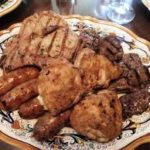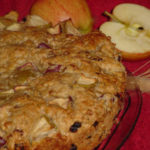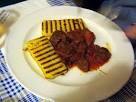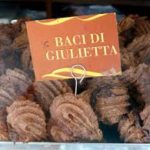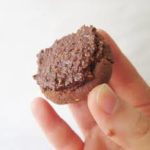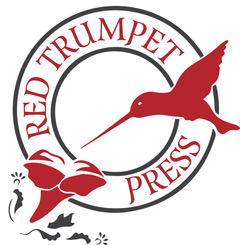I love food (too much, it turns out). And one of my favorite cuisines is Italian. So when writing a novel based in Verona, Italy, of course I had to include some dining scenes with characters enjoying dishes that were at least Italian, if not precisely from Verona. I had to do a bit of research about what a Veronese (a person from Verona) eats.
 I had some fun with it. My main character, Dani Dunn, who is originally from Verona, runs an inn and restaurant in the bayside village of Little Eden in northern California. One of the threads running through the novels Sinner’s Grove and The Lair is the fact that Gabe de la Torre, a local detective (also from Verona), absolutely craves the Italian dishes from her restaurant. They’re delicious, but more than that, they remind him of his childhood. He even jokes about using her cuisine as payment for services rendered:
I had some fun with it. My main character, Dani Dunn, who is originally from Verona, runs an inn and restaurant in the bayside village of Little Eden in northern California. One of the threads running through the novels Sinner’s Grove and The Lair is the fact that Gabe de la Torre, a local detective (also from Verona), absolutely craves the Italian dishes from her restaurant. They’re delicious, but more than that, they remind him of his childhood. He even jokes about using her cuisine as payment for services rendered:
“Okay, what did [Paulo and Nina] offer you to babysit me?” she’d demanded. “A year’s worth of Risotto del Veneto?”
“You wound me, Daniela, [Gabe] replied with a grin. “As much as I love your risotto, you know I’d hold out for nothing less than Ravioli della Toscana and Venetian Meatloaf.”
The secret to Dani’s cooking is revealed during the course of The Lair, but in the meantime, my mouth waters just thinking about such fare—all of which is a figment of my imagination (although maybe someday I’ll create my own selections worthy of the names).
Aside from loving Italian food, I wanted to touch upon the different “levels” of cuisine in Italy; as in every country, there’s food the elites eat, and food that common people enjoy. I used the difference in cuisine as one way to illustrate the class distinctions in the story.
Dani, for example, comes from a very affluent family, and the wake for her father provides a glimpse into the gastronomical world of the upper class. Chateaubriand, truffles, Beluga caviar and other incredibly expensive international delicacies are on the menu. The following day, Dani’s uncle takes her to lunch at one of his hotel company’s posh restaurants. He wants to order for her. “You must try the Aragosta fra Diavolo”, he says.
I had checked out some upscale Italian dishes, and this seemed to fit the bill for my scene. Aragosta means lobster, and fra diavolo, which means something along the lines of “Brother Devil,” implies a spicy, hot flavor. Traditionally, the whole lobster is used, although today lobster tails, and even chunks of lobster,are used out of convenience.
Here’s a link to a yummy-sounding recipe:
http://memoriediangelina.com/2013/10/13/lobster-fra-diavolo/
WHAT ABOUT THE REST OF US?
It turns out that regular Italians generally eat the same kinds of food that Americans do, without the taint of so much fast food. Pasta, salad, grilled meats, vegetables, desserts—all form the typical Italian menu. In one scene, Dani and Gabe are having dinner at the home of one of Gabe’s childhood friends and his wife. She serves a grigliata mista, or mixed grill. In other words, they like to barbeque! The Italian version of what we usually refer to as shishkebab is called spiedini, which consists of small chunks of meat or fish on a skewer. Slices of baguette-style bread sometimes separate the meat, but veggies are also popular.
Here are some sites that talk about Italian grilling:
http://jovinacooksitalian.com/tag/spiedini/
http://italianfood.about.com/od/italianmeatrecipes/a/aa082508.htm
AND FOR DESSERT…
I thought this cake sounded splendid, and I pictured it for the end of the dinner party scene. You can play with the recipe a little bit; for example, you can change the nut variety or omit nuts altogether; same with raisins and/or coconut (but it would be a shame if you did). You can also substitute flour – say, half white, half whole wheat or gluten-free, or substitute a sugar alternative like Stevia for a less fattening version.
Italian Apple Cake
(courtesy Kookaburra via Food.com)
INGREDIENTS
- 2 cooking applies (e.g. Fuji, Jonagold, Pippin, Rome)
- Juice of 1/2 lemon
- ½ cup raisins
- ½ cup walnuts
- 1 T. sugar
- ½ cup shredded coconut (use unsweetened if you can)
- 1.5 cups all-purpose flour
- 1 tsp. baking powder
- 1 tsp. cinnamon
- 1 tsp. nutmeg
- 2 large eggs
- ¾ cups sugar
- 10.5 T. butter, melted
- 2 T. Amaretto liqueur or substitute a couple drops of almond extract or even omit
- Confectioner’s sugar for dusting
- Whipped cream or ice cream to serve with cake (if you can afford the calories!)
DIRECTIONS
- Set oven to 350 degrees.
- Grease and lightly flour a 9 inch round cake pan.
- Cut UNPEELED apples into ½” chunks – discard the core.
- In a medium bowl, toss apples with lemon juice to avoid discoloration, then drain extra lemon juice.
- Add raisins and coconut to apples.
- Spread nuts on cutting board and chop roughly with 1T. sugar. Add to apples and mix well.
- In large bowl, sift flower, baking powder, cinnamon and nutmeg.
- In separate bowl, combine eggs and sugar and beat until light and lemon-colored.
- While beating, add melted butter and liqueur or extract.
- Make a well in the flour mixture and add the egg mixture; stir until well combined
- Add apple mixture and mix well; don’t worry if it seems like there’s not enough batter!
- Pour into pan and bake on center rack for about 4 5-50 minutes or until top is golden brown.
- Cool on rack and sprinkle with confectioner’s sugar.
- Serve alone or with whipped cream or ice cream
- Enjoy the ooh’s and ahh’s from your guests!
NOW FROM A REAL VERONESE…
My dear friend Anna filled me in on the dishes that she grew up with. “Around Christmastime,” she says, “we have a cake which we call Pandoro. And for December 13th, St. Lucia Day, we have Pastafrolle di Santa Lucia, which is a kind of shortbread cookie. We will often have Recioto, a strong red wine that is excellent for dessert.
“Then there’s Bigoli con la sardela, which is handmade spaghetti with a special herring sauce that we eat on Ash Wednesday. Another dish is Lesso con la peara, which is boiled beef meat with a peppered and marrow sauce.”
Anna told me about one more dish that I don’t think I’ll ever have the heart to try: it’s called pastissade de caval, or “horse stew.” Apparently It is a very sweet meat and the dish is popular.
Nope. Not gonna do it. But then, I feel the same way about eating beef tongue.
Finally, Anna mentioned another Christmas cookie, which I found perfect to end this blog post with. The confections are called Baci di Giuletta or “Juliet’s Kisses.” Made of hazelnut and chocolate, they were created by Enzo Perlini of Verona’s celebrated Pasticceria Perlini. http://www.pasticceriaperlini.it/
INGREDIENTS
For the cookies:
1 ½ cups hazelnuts, blanched, peeled and toasted
¾ cup granulated sugar
2 ½ T. unsweetened cocoa powder (best quality)
4 large egg whites
For the filling:
8 T. margarine (butter is too soft)
½ cup powdered sugar
1 tsp. rum, Cognac or Grand Marnier
¼ cup unsweetened cocoa powder
1 ½ ounce bittersweet chocolate, melted and cooled (this helps solidify the mixture).
To make the cookies, combine the hazelnuts with ¼ cup of the sugar in a food processor. Pulse until the nuts are ground to a fine powder (processing continually will cause the mixture to become oily). Transfer to a bowl and stir in the cocoa powder.
In the bowl of a standing electric mixer, beat the egg whites on medium speed until frothy. Increase the speed to high and gradually add the remaining sugar. Beat the whites until glossy and stiff, but not dry.
Gradually fold the nut mixture into the whites, turning the bowl as you go. Work slowly and gently to keep the egg whites firm.
Line several cookie sheets with parchment paper, or use non-stick cookie sheets. Fit a pastry bag with a ¼ inch wide star tip. Working with half the batter at a time, gently fill the bag. Hold the bag vertically about two inches from the cookie sheet and pipe out forms that are slightly bigger than a
quarter (the batter must fall from the tip and not be pressed against the sheet). Pipe out one at a time, 1 ½ inches apart, mobbing on to the next with a flipping motion that leaves lines in the dough. You should have about 80 small cookies. Set aside and let rest, uncovered and undisturbed, for 24 hours at room temperature.
Preheat the oven to 250 degrees F. Working two sheets at a time, bake the cookies until slightly firm to the touch, about 10 minutes. Remove and completely cool on the sheets. Loosen carefully with a spatula and set aside.
To prepare the filling, combine the margarine and powdered sugar in the bowl of a standing mixer. Beat on low speed until smooth. Add the rum, cocoa powder and melted chocolate. Mix until blended (Makes about one cup filling.
Use a pastry bag or small spoon to put a dot of filling—about one teaspoon— on the sides of half the cookies. Add another cookie to each and gentle press together. Set aside at room temperature until the filling has solidified, about an hour. Makes about 40 baci.
I’ll leave you with a bit of trivia: As you know from previous posts, I play bocce in the summer. The Italian word Bocce means “balls.” Makes sense, right? But when you play the game, and your ball hits the little white target ball (known as the “pallino”), it’s customary to call out “baci!” It’s pronounced the same way, except that it means “kiss” because your ball is “kissing” the pallino!
I hope you get a chance to try the recipes I’ve listed above. If you do, please let me know how you like them. What if anything did you change?
Until next time, buon appetito!

